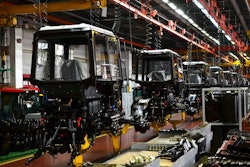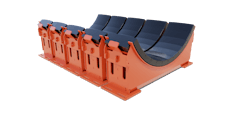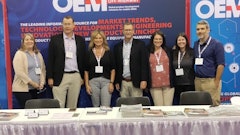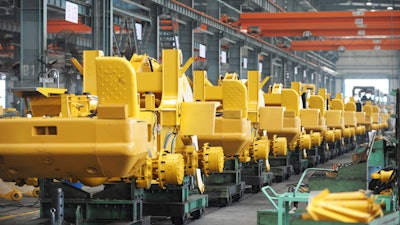
Economic activity in the manufacturing sector grew in July, with the overall economy notching a 14th consecutive month of growth, say the nation's supply executives in the latest Manufacturing ISM Report On Business.
The report was issued by Timothy R. Fiore, chair of the Institute for Supply Management (ISM) Manufacturing Business Survey Committee.
“The July Manufacturing PMI registered 59.5%, a decrease of 1.1 percentage points from the June reading of 60.6%,” he says. “This figure indicates expansion in the overall economy for the 14th month in a row after contraction in April 2020.”
Entering the third quarter, all segments of the manufacturing economy are impacted by near record-long raw-material lead times, continued shortages of critical basic materials, rising commodities prices and difficulties in transporting products, he says.
The Manufacturing PMI, or the Purchasing Managers’ Index, is a set of economic indicators based off surveys of private-sector companies.
By the Numbers
The New Orders Index registered 64.9%, decreasing 1.1 percentage points from the June reading of 66%. The Production Index registered 58.4%, a decrease of 2.4 percentage points, compared to the June reading of 60.8%. The Prices Index registered 85.7%, down 6.4 percentage points, compared to the June figure of 92.1%, which was the index's highest reading since July 1979 (93.1%).
The Backlog of Orders Index registered 65%, 0.5 percentage point higher than the June reading of 64.5%. The Employment Index registered 52.9%, 3 percentage points higher compared to the June reading of 49.9%. The Supplier Deliveries Index registered 72.5%, down 2.6 percentage points from the June figure of 75.1%. The Inventories Index registered 48.9%, 2.2 percentage points lower than the June reading of 51.1%.
The New Export Orders Index registered 55.7%, a decrease of 0.5 percentage point compared to the June reading of 56.2%. The Imports Index registered 53.7%, a 7.3-percentage point decrease from the June reading of 61%.
“Business Survey Committee panelists reported that their companies and suppliers continue to struggle to meet increasing demand levels,” Fiore says. “As we enter the third quarter, all segments of the manufacturing economy are impacted by near record-long raw-material lead times, continued shortages of critical basic materials, rising commodities prices and difficulties in transporting products. Worker absenteeism, short-term shutdowns due to parts shortages and difficulties in filling open positions continue to be issues limiting manufacturing-growth potential. Optimistic panel sentiment remained strong, with 13 positive comments for every cautious comment.”
 August ISM PMI Manufacturing at a Glance.Institute for Supply Management
August ISM PMI Manufacturing at a Glance.Institute for Supply Management
Increasing Demand for Manufacturing
Demand expanded, with the New Orders Index growing, supported by continued expansion of the New Export Orders Index, while the Customers' Inventories Index remained at very low levels and the Backlog of Orders Index stayed at a very high level, Fiore says.
Consumption, measured by the Production and Employment indexes, improved in the period, posting a combined 0.6-percentage point increase to the Manufacturing PMI calculation.
The Employment Index returned to expansion after one month of contraction.
“Panelists continued to note significant difficulties in attracting and retaining labor at their companies' and suppliers' facilities, although there were signs of improvement,” he says. “Inputs — expressed as supplier deliveries, inventories, and imports — continued to support input-driven constraints to production expansion, at slower rates compared to June, as the Supplier Deliveries Index softened, while the Inventories Index contracted, likely due to long lead times. The Prices Index expanded for the 14th consecutive month, indicating continued supplier pricing power and scarcity of supply chain goods.”
All of the six biggest manufacturing industries — computer and electronic products; fabricated metal products; chemical products; food, beverage and tobacco products; transportation equipment; and petroleum and coal products, in that order — registered moderate to strong growth in July.
“Manufacturing performed well for the 14th straight month, with demand, consumption and inputs registering growth compared to June,” Fiore says. “Panelists' companies and their supply chains continue to struggle to respond to strong demand due to difficulties in hiring and retaining direct labor. Comments indicate slight improvements in labor and supplier deliveries, offset by continued problems in the transportation sector. High backlog levels, too low customers' inventories and near record raw materials lead times continue to be reported. Labor challenges across the entire value chain and transportation inefficiencies are the major obstacles to increasing growth.”
Seventeen of 18 manufacturing industries reported growth in July, in the following order: furniture and related products; printing and related support activities; apparel, leather and allied products; miscellaneous manufacturing; computer and electronic products; nonmetallic mineral products; machinery; fabricated metal products; paper products; chemical products; food, beverage and tobacco products; primary metals; plastics and rubber products; transportation equipment; electrical equipment, appliances and components; wood products; and petroleum and coal products. The only industry reporting a decrease in July compared to June was textile mills.
“(We) continue to have hiring difficulties and are unable to fill production and salaried jobs (due to) a lack of candidates,” says one survey respondent in fabricated metal products. “Raw materials are still in short supply, with longer lead times.”
A survey respondent in the nonmetallic mineral products sector, which includes cement and concrete product manufacturing says, “sales are above last year by a good percentage, but meeting demand is just not possible due to force majeure situations, logistics, and labor shortages. We don't anticipate this ending until well into 2022.”
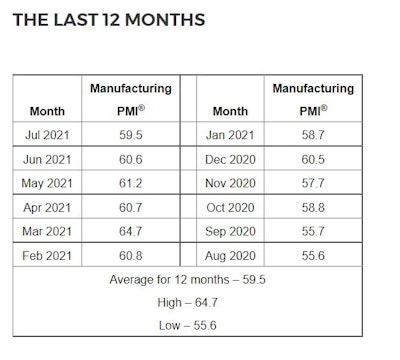 Institute for Supply Management
Institute for Supply Management
Commodities Price Changes
Commodities experiencing an increase in price last month include (the number of consecutive months the commodity is listed is indicated after each item): adhesives; aluminum (14); aluminum products (four); ammonia; cable and harnesses; capacitors; caustic soda (two); coatings (four); copper (14); corrugate (10); corrugated packaging (nine); crude oil (two); diesel fuel (seven); electrical components (eight); electrical motors; electronic components (eight); ethylene; freight (nine); high-density polyethylene (HDPE) (seven); hydraulic components; labor - temporary (three); lumber (13); medium-density fiberboard (MDF); natural gas; ocean freight (eight); packaging film; packaging supplies (eight); pallets; paper products; phosphates; plastic resins (11); polyethylene (six); polyols; polypropylene (13); polyvinyl chloride (PVC) products (two); printed circuit board assemblies (PCBAS); propylene; resin-based products (six); resins; resistors; semiconductors (six); shipping containers; solvents; steel (12); steel - carbon (eight); steel - hot rolled (11); steel - scrap (three); steel - stainless (9); steel products (11); steel wire; sulfuric acid; totes; wood (two); and wood products (two).
Copper and lumber are down in price, while commodities in short supply include: adhesives and paint; aluminum (four); aluminum products (three); capacitors; chlorine; corrugate (two); corrugated packaging; electrical components (10); electronic components (eight); freight; hardware; hydraulic components; labor - temporary (three); lumber; nylon polymer; ocean freight (four); packaging supplies (two); paper (two); phosphates; plastic products (six); plastic resins - other (five); polyols; polyvinyl chloride (PVC) resin (three); personal protective equipment (PPE) - gloves; resistors; semiconductors (eight); steel (eight); steel - carbon; steel - cold rolled (three); steel - hot rolled (nine); steel - stainless (five); steel drums; steel products (six); steel wire; totes; and wood - pallets (four).
Index Summaries
A Manufacturing PMI above 43.1%, over a period of time, generally indicates an expansion of the overall economy, according to Fiore. Therefore, the July Manufacturing PMI indicates the overall economy grew in July for the 14th consecutive month following contraction in April 2020.
“The past relationship between the Manufacturing PMI and the overall economy indicates that the Manufacturing PMI for July (59.5%) corresponds to a 4.7% increase in real gross domestic product (GDP) on an annualized basis,” he says.
The New Orders and Production indexes continued to expand at strong levels. The Supplier Deliveries Index continued to reflect suppliers' difficulties in maintaining delivery rates, due to a lack of direct labor, transportation challenges and sustained levels of increasing demand, Fiore says.
“Nine out of 10 subindexes were positive for the period; a reading of 'too low' for Customers' Inventories Index is considered a positive for future production,” he says.
A reading above 50% indicates that the manufacturing economy is generally expanding; below 50% indicates that it is generally contracting.
ISM's New Orders Index registered 64.9% in July, down 1.1 percentage points compared to the 66% reported in June. A New Orders Index above 52.8%, over time, is generally consistent with an increase in the Census Bureau's series on manufacturing orders (in constant 2000 dollars).
Of the 18 manufacturing industries, the 15 that reported growth in new orders in July, in the following order, are: furniture and related products; computer and electronic products; printing and related support activities; machinery; miscellaneous manufacturing; paper products; electrical equipment, appliances and components; chemical products; food, beverage and tobacco products; transportation equipment; fabricated metal products; petroleum and coal products; nonmetallic mineral products; plastics and rubber products; and primary metals. The only industry reporting a decline in new orders in July is textile mills.
Workforce Shortage
ISM's Employment Index registered 52.9% in July, 3 percentage points higher than the June reading of 49.9%.
“The Employment Index returned to expansionary territory after dipping below 50%,” Fiore says. “Of the six big manufacturing sectors, four (computer and electronic products; fabricated metal products; transportation equipment; and food, beverage and tobacco products) expanded. Strong new-order levels, low customers' inventories and expanding backlogs continue to support employment strength. However, survey panelists' companies are still struggling to meet labor-management plans, but less so compared to prior months. An overwhelming majority of panelists indicate their companies are hiring or attempting to hire, with about 30% of comments — a slight decrease from previous months — expressing difficulty in filling positions. A significant number of panelists note increasing employee-turnover rates.”
An Employment Index above 50.6% over time is generally consistent with an increase in the Bureau of Labor Statistics (BLS) data on manufacturing employment.
Of the 18 manufacturing industries, the 11 industries reporting employment growth in July, in the following order, are: furniture and related products; printing and related support activities; miscellaneous manufacturing; machinery; nonmetallic mineral products; computer and electronic products; electrical equipment, appliances and components; fabricated metal products; primary metals; transportation equipment; and food, beverage and tobacco products.
“(We’re) very busy with new orders,” one manufacturing survey respondent says. “Material costs continue to rise, and supplies are sometimes delayed. Labor issues are still affecting us the most with finding proper labor. Labor costs are increasing as we are competing locally for top talent.”
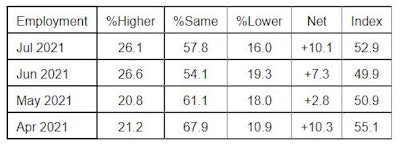 Institute for Supply Management
Institute for Supply Management
Supplier Deliveries
The delivery performance of suppliers to manufacturing organizations was slower in July, as the Supplier Deliveries Index registered 72.5%, 2.6 percentage points lower than the 75.1% reported in June and the second straight month of slowing expansion. A reading below 50% indicates faster deliveries, while a reading above 50% indicates slower deliveries.
All the top manufacturing industries reported slowing deliveries, according to Fiore. “Deliveries slowed at a slower rate compared to the previous month, but the index continues to reflect difficulties suppliers are experiencing in meeting customer demand, including ongoing hiring challenges, product shortages, extended raw-materials lead times and stubbornly high prices, and inconsistent transportation availability,” he says.
All 18 industries reported slower supplier deliveries in July, in the following order: apparel, leather and allied products; furniture and related products; paper products; plastics and rubber products; nonmetallic mineral products; fabricated metal products; computer and electronic products; machinery; miscellaneous manufacturing; printing and related support activities; food, beverage and tobacco products; transportation equipment; chemical products; textile mills; wood products; electrical equipment, appliances and components; primary metals; and petroleum and coal products.
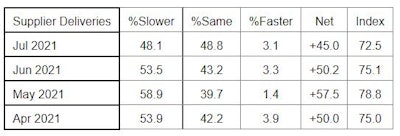 Institute for Supply Management
Institute for Supply Management
Prices Index
The ISM Prices Index registered 85.7%, a decrease of 6.4 percentage points compared to the June reading of 92.1%, indicating raw-materials prices increased for the 14th consecutive month but at slower levels. This is the index's seventh straight month above 80%.
“Aluminum, basic chemicals, packaging supplies, electrical and electronic components, energy, some plastics and plastic products, freight and steels continue to remain at elevated prices due to some product scarcity, but supply and demand dynamics appear to be moving closer to equilibrium for the first time in many months,” Fiore says.
A Prices Index above 52.7%, over time, is generally consistent with an increase in the Bureau of Labor Statistics (BLS) Producer Price Index for Intermediate Materials.
In July, all 18 industries reported paying increased prices for raw materials, in the following order: apparel, leather and allied products; paper products; printing and related support activities; nonmetallic mineral products; plastics and rubber products; furniture and related products; fabricated metal products; miscellaneous manufacturing; petroleum and coal products; electrical equipment, appliances and components; machinery; primary metals; transportation equipment; computer and electronic products; textile mills; chemical products; food, beverage and tobacco products; and wood products.
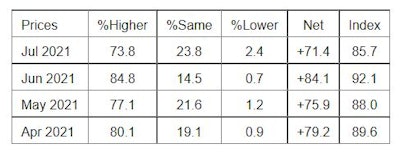 Institute for Supply Management
Institute for Supply Management
Order Backlog
ISM's Backlog of Orders Index registered 65% in July, a 0.5-percentage point increase compared to the 64.5% reported in June, indicating order backlogs expanded for the 13th straight month. “Backlogs expanded at similar rates in July compared to June, indicating production was able to maintain the level of backlog growth even with continuing strong new order levels,” Fiore says.
The 15 industries reporting growth in order backlogs in July, in the following order, are: apparel, leather and allied products; furniture and related products; plastics and rubber products; paper products; computer and electronic products; transportation equipment; machinery; fabricated metal products; textile mills; electrical equipment, appliances and components; miscellaneous manufacturing; nonmetallic mineral products; chemical products; primary metals; and food, beverage and tobacco products. No industry reported lower backlogs in July compared to June.
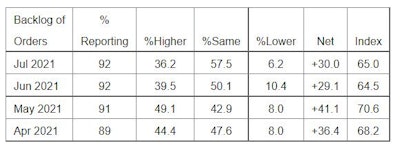 Institute for Supply Management
Institute for Supply Management






